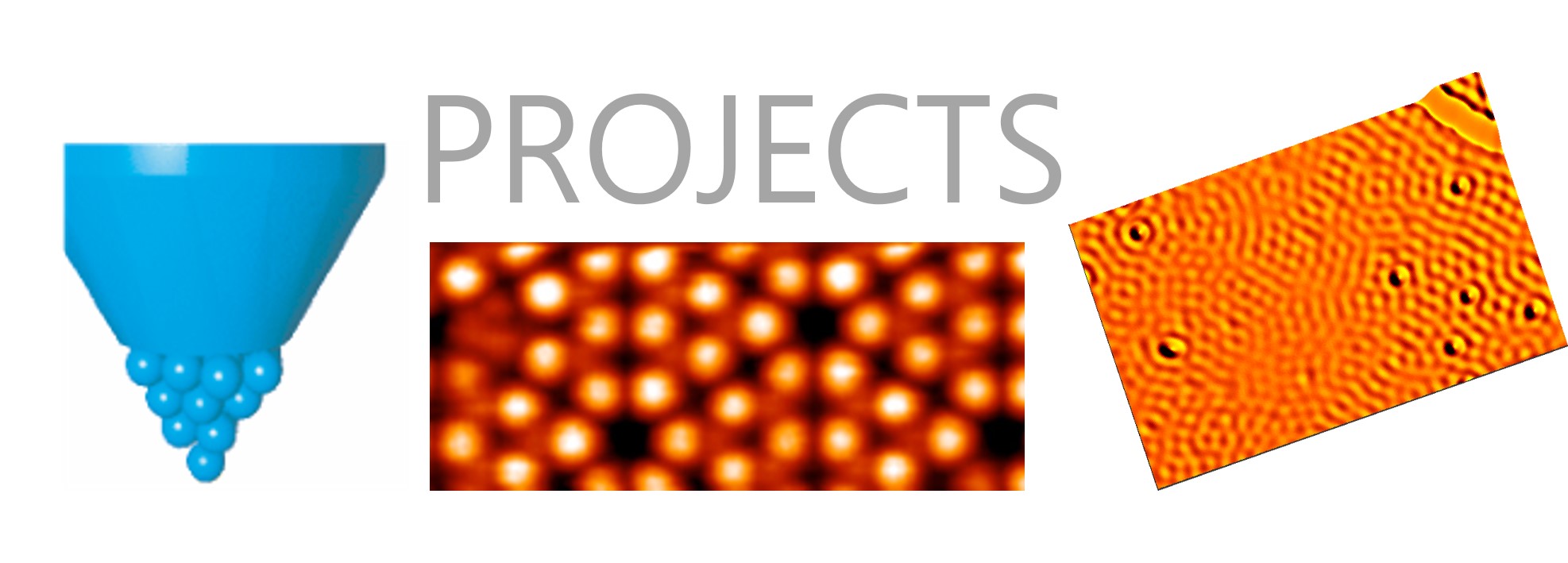é·è°·å·ç 究室ã§ã¯ãèµ°æ»ãã³ãã«é¡å¾®é¡ï¼ï¼³ï¼´ï¼ï¼ã使ã£ã¦ã表é¢ä¸ã§ã®ããã¹ã±ã¼ã«ã§ã®è§£æãé²ãã¦ãã¾ãã
STï¼ã¯ãæ¢éï¼ããã¼ãï¼ã¨å¼ã°ããéã観å¯ããã試æ表é¢ã«è¿ã¥ãã表é¢ããªãããã¨ã«ãã£ã¦è¡¨é¢ã®å¹å¸ãè¦ãé¡å¾®é¡ã§ããéã¨è©¦æã¨ã®éã«æµãããã³ãã«é»æµãå©ç¨ãããã¨ã«ãã£ã¦ãéãååæ°ååã»ã©é¢ããä½ç½®ã«ä¿æããªãããªãããã¨ãã§ããã®ã§ã表é¢ä¸ã®ååã¹ã±ã¼ã«ã®å¹å¸ãããªãã¡åååãæ®ããã¨ãã§ãã¾ããèµ°æ»ãã³ãã«åå ï¼ï¼³ï¼´ï¼³)ã¨å¼ã°ããææ³ãä½µç¨ããã°ãéç´ä¸ã®è©¦æ表é¢ã§ã®é»åç¶æ ã«é¢ããæ å ±ãå¾ããã¨ãã§ãã¾ãã
é·è°·å·ç 究室ã§ã¯ç¹ã«ãä½æ¸©ã»ç£å ´ä¸ã»RFç°å¢ä¸ãªã©ã®ç¹æ®ç°å¢ä¸ã§ã® 精度ã®é«ã測å®ã«ãã ãã£ã¦ããã ä»ã®ææ³ã§ã¯å¾ãããªãç¾è±¡ã®è¦³æ¸¬ãç®æãã¦ãã¾ãã
ããã«æ¸ããã¦ããç 究å 容ã®ä»ã«ããæ§ã ãªå ±åç 究ãè£ ç½®éçºãªã©ãè¡ã£ã¦ãã¾ãã
We are working on studies of surface science in nanometer scale using scanning tunneling microscopy (STM).
STM detects a topography by scanning a very sharp tip closely above a sample surface. Tip-sample distance can be stabilized by detecting tunneling current which changes dramatically depending on the tip-sample distance. By scanning tunneling spectroscopy (STS), we can get information about electronic states in atomic scales.
Especially, we focus on precise measurements in extreme conditions, such as low temperature, high magnetic field, RF electromagnetic field.
Besides the above subjects, we are working on various joint researches and system developments.
1. 表é¢äºæ¬¡å
é»åç³»ã®ç©æ§è¦³æ¸¬ (Electronic states of two dimensional systems)

表é¢æ°åå層ã«å±å¨ããé»åç¶æ
ãæã¤è¡¨é¢ç³»ãå©ç¨ãã¦äºæ¬¡å
é»åç³»ã«é¢ãããã¾ãã¾ãªç¾è±¡ã®å®ç©ºé観å¯ãç®æãã¦ãã¾ãã
対象ã¯ãå¸çååãªã©è¡¨é¢æ§é ã¨ã®ç¸äºä½ç¨ãéãè¾¼ãå¹æãé»åå®å¨æ³¢ã»ããªã¼ãã«æ¯åã»é®è½å¹æããã©ãã³ã¨ã®ç¸äºä½ç¨ã«ãããã§ã«ãé¢è¿åã®é»åç¶æ
ãè¿è¤å¹æãªã©ãªã©ãä½æ¸©ï¼æ¶²ä½ããªã¦ã ï¼è¶
é«ç空走æ»ãã³ãã«é¡å¾®é¡ï¼ï¼³ï¼´ï¼ï¼ãç¨ãããã³ãã«åå
ã«ããé«ç²¾åº¦ã§ã®é»åç¶æ
測å®æè¡ãéµã¨ãªãã¾ãã
We are working on real space measurements of electronic systems confined in a few atomic layers.
Our interests are various phenomena of surface, such as interactions between substrates and adatoms, standing waves, Friedel oscillations, shielding effects, electron-phonon interactions, and Kondo effects.
Ultrahigh vacuum and low temperature conditions are the key role to reveal high resolution STM measurements.
References:
M. Ono et al.,Appl. Surf. Sci. 256, 469-474 (2009)
M. Ono et al.,Phys. Rev. Lett. 96, 016801 (2006)
2. ãããµã¤ãºè¶ ä¼å°ä½ (Nano-sized superconducting materials)
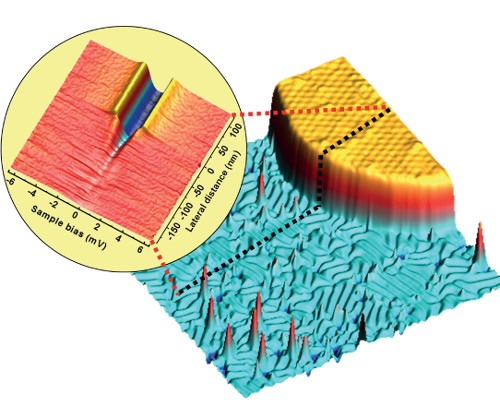
ã·ãªã³ã³åºæ¿ä¸ã«è¶ ä¼å°ä½ã§ããéãè¸çãããã¨ã«ãã£ã¦ãã¢ã¤ã©ã³ãæ§é ãåå±¤è¶ ä¼å°èèãä½è£½ãããã®è¶ ä¼å°ç¹æ§ããã³ãã«åå 測å®ã«ããè©ä¾¡ãã¦ãã¾ãããµã¤ãºã»å½¢ç¶ä¾åæ§ãç£å ´ä¸ã§ã®ç£æã®ä¾µå ¥ç¹æ§ãããã¦å¸¸ä¼å°ä½ã¸ã®è¶ ä¼å°ç¹æ§ã®ãã¿åºãã«èå³ãæã£ã¦ç 究ãè¡ã£ã¦ãã¾ããä¸çã§ãç¨å°ãªããªã¦ã ï¼å·å´ï¼å°é温度ï¼ï¼ï¼ï¼«ä»¥ä¸ï¼ã®è¶ é«ç空STï¼ã«ãã測å®ãã¦ãããï½ï½ V以ä¸ã®ç²¾åº¦ã§ã®è¨æ¸¬ãå¯è½ã§ãã
We are interested in superconducting properties of nano sized island and films of superconductors (e.g., Pb). Superconducting properties, such as formation of vortices, proximity effect, and critical field) depending on size and shape are studied by low temperature (~0.4K) and ultrahigh vacuum STM.
References:
H. Kim et al.,Phys. Rev. Lett. 117, 116802 (2016)
H. Kim and Y. Hasegawa Phys. Rev. Lett. 114, 206801 (2015).
ãªã©
3. 表é¢å¸çååã®ç£æ§ã¨ã¹ãã³å極STM (Magnetic molecules studied by spin-polarized STM)

ç£æ§æ¢éãç¨ãã¦ç£æ§è¡¨é¢ã測å®ããã¨ããã³ãã«ç£æ°æµæå¹æã«ãã£ã¦æ¢éã¨ãµã³ãã«ã®ç£åã®åãã«ä¾åãã¦ãã³ãã«é»æµãå¤åããããã«ã表é¢ã«ãããç£æ°æ§é ãååã¹ã±ã¼ã«ã§è©³ç´°ã«èª¿ã¹ããã¨ãå¯è½ã¨ãªãã¾ããã¾ãã表é¢ããç£æ§ä½ã«å¯¾ãã¦æ§ã ãªç£å ´ã§æ¸¬å®ãè¡ããã¨ã§ããã®ç£æ§ä½ã®ç£åæ²ç·ãæããã¨ãå¯è½ã§ããç¾å¨ã¯ããã®å¯¾è±¡ã¨ãã¦ç£æ§ååã«èå³ãæã£ã¦ç 究ãè¡ã£ã¦ãã¾ããæçµçã«ã¯ãã¹ãã³å極STMã¨ååãããã¥ã¬ã¼ã·ã§ã³ãçµã¿åããã¦ãä½æ¬¡å éåã¹ãã³ç³»ã表é¢ä¸ã§æ§æãããã®éåç£æ§ã調ã¹ããã¨ãç®æãã¦ãã¾ãã
When a magnetic tip is used for scanning, sample magnetic structures in nanoscale can be investigated by detecting tunneling magnetoresistance between a tip and a sample. In addition, magnetization curve can be measured in magnetic fields. We are interested in magnetic molecules, taking into consideration to build up a low dimensional system by the atomic/molecule manipulation technique.
ç 究ææï¼
S. Yamamoto et al.,Phys. Rev. B 93, 081408(R) (2016)
ãªã©
4. ã¹ãã³å極STMã«ããéå ç´ åºæ¿ä¸ã®3dç£æ§éå±èèã®ç 究 (Chiral magnetism studied by spin-polarized STM)
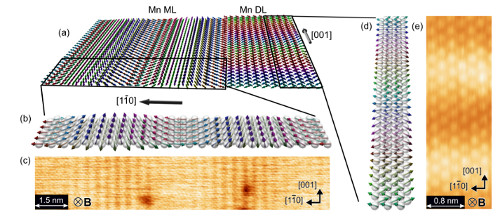
éãåºæ¿ä¸ã®ç£æ§èè (ã¿ã³ã°ã¹ãã³è¡¨é¢ä¸ã®3dç£æ§éå±èèãªã©) ã¯ãã¸ã£ãã·ã³ã¹ãã¼å®è°·ç¸äºä½ç¨ã«ãã£ã¦è¤éãªç£æ°æ§é ãç¾ãã¾ããæã ã¯ã¹ãã³å極STMã«ãã£ã¦ãã®ç£æ°æ§é ãå±èµ·ç¶æ ã®ç 究ã«åãçµãã§ãã¾ãã
Complex magnetic structures appear due to the Dzyaloshinskii-Moriya interaction on magnetic thin films formed on heavy metals, such as 3d magnetic metal thin films on a tungsten substrate. We study the magnetic structures and excitation state in a nanometer scale.
ç 究ææï¼
M. Haze et al., Sci. Rep. 7, 13269 (2017).
M. Haze et al., Phys. Rev. B 95, 060415(R) (2017).
ãªã©
5. éãé»åç³»è¶ ä¼å°ä½ã®STM/STS (STM/STS studies of heavy fermion materials)
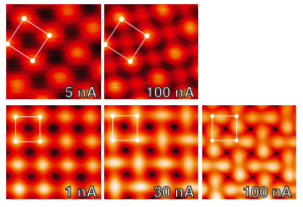
BCSçè«ã§ã¯èª¬æãããã¨ãã§ããªãç£æ§ã¨å ±åããç¹ç°ãªè¶ ä¼å°ä½ã«å¯¾ããããªã¦ã ï¼å·å´ï¼å°é温度ï¼ï¼ï¼ï¼«ä»¥ä¸ï¼ã®è¶ é«ç空STï¼ãç¨ãã¦èµ°æ»ãã³ãã«åå ã®ç©ºéãããã³ã°ãè¡ããã¨ã§ãã®ç©æ§ãæããã«ããç 究ãè¡ã£ã¦ãã¾ãã ã¾ããã®ãããªéå¾æ¥è¶ ä¼å°ã¨ç£æ§ã¨ã¨ã®é¢ããã¹ãã³å極STMã«ãã£ã¦æããã«ãããã¨ãç®æãã¦ãã¾ãã
Unconventional superconductivity, which cannot be explained by BCS theory, is studied by He3 low temperature (~0.4K) STM/STS. Moreover, the relationship between unconventional superconductivity and magnetism is studied by spin-polarized STM.
ç 究ææï¼
H. Kim et al., Sci. Adv. 3, eaao0362 (2017)
ãªã©
6. èµ°æ»ãã³ãã«ã»ããã³ã·ã§ã¡ããªã¼ã«ãã表é¢é»æ°ä¼å°ã®ç 究 (Surface conductivity studied by scanning tunneling potentiometry)
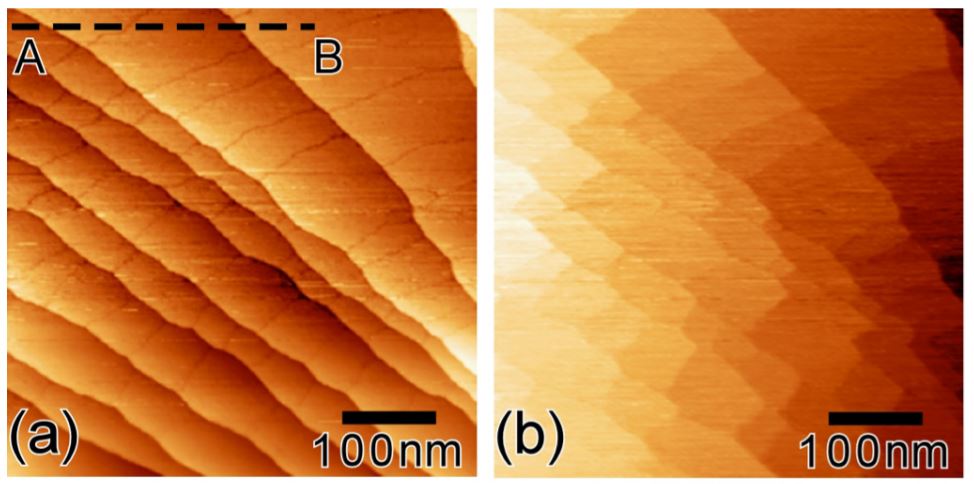
èµ°æ»ãã³ãã«ããã³ã·ã§ã¡ããªã¼ã¨ã¯ã表é¢ã®é»ä½ã®ç©ºéåå¸ãé常ã«é«ç²¾åº¦ã«èª¿ã¹ããã¨ãã§ãã測å®æ段ã§ã試æã®ä¸¡ç«¯ã«é»å§ãããã¦ãã¼ããã¤ã¢ã¹ä»è¿ã§ãã³ãã«é»æµãã¼ãã«ãªãããã«ãæ¢éï¼è©¦æéã®ãã¤ã¢ã¹é»å§ããã£ã¼ãããã¯å¶å¾¡ãããã¨ã«ãããé»ä½ã決å®ãããã¨ãã§ããããããã¯ãã®æ¸¬å®æ³ã¨ã¹ãã³å極STMã¨çµã¿åããã¦ãã¹ãã³æµã®ç©ºéåå¸ã調ã¹ããã¨ãç®çã¨ãã¦ç 究ãé²ãã¦ãã¾ãã
Scanning tunneling potentiometry is a powerful tool to study surface conductivity in nanoscale. We are interested in surface conductivity of Si(111)-7×7, thin film, and topological materials. We are also interested in detection of spin current by the combination with spin-polarized STM in low temperature.
ç 究ææï¼
M. Hamada and Y. Hasegawa,Phys. Rev. B 99, 125402 (2019).
M. Hamada and Y. Hasegawa, Jpn. J. Appl. Phys. 51, 125202 (2012)
ãªã©
